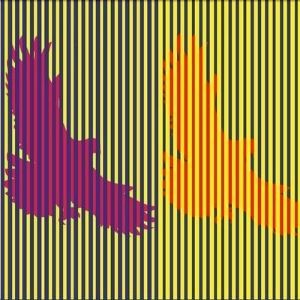Illusions can take decades of work for vision experts and neuroscientists to perfect, as they have been designed to tease out and discover very specific methods that our brains use to decode the world around us. This involves shortcuts that save on mental processing, and are actually very accurate...99% of the time. Here we will look at the 1% of the time when things don't match reality. Here are 6 examples that reveal different ways our brains use perceptual shortcuts.
Without giving the video away, this special type of perceptual illusion demonstrates a couple of interesting ways our sensory processes work that we're generally unaware of.
Note you will need to turn sound on.
1. How cross-modal sensory processing can trigger one sense to change how another sense is experienced (think of how smell influences taste). In this case sound and vision.
2. How a future stimulus can change the way you perceive the past (on very short timescales). A phenomenon known as 'postdiction'.
Here is a graphical illustration of the effect.


This illusion is known as the 'Bezold effect', named after the meteorologist who discovered it over a century ago.
You probably surmised the eagles are the exact same color. Although our eyes receive the alternating color bars distinctly, because they are in close proximity, a color assimilation in our visual processing occurs - AKA 'spreading'.
It acts like a type of spatial color mixing, but done with our brains rather than a palette. As with most illusions, the effect is specific to the stimuli, i.e. increasing the width of the bars apart reduces the effect.
Interestingly though, when large areas of color are placed adjacent to each other, the opposite occurs and color contrast actually causes polarization.
This type of illusion demonstrates clearly how spatial information and color interpretation are closely intertwined in our visual systems.

This image was created by Utrecht University neuroscientist Ryota Kanai, and is a variation of a grid illusion.
It's interesting in two ways.
Firstly, there are a number of black dots in the image, but it is tricky to find them until you scan most of the image by moving your central focus around.
Secondly, when focusing on a black dot you will notice the other black dots that you could see, quickly fade to nothing. While focusing on one, only 3 or 4 at most can be perceived simultaneously.
There is still some mystery and debate about the visual mechanisms behind this illusion, but a partial explanation is our surprising lack of ability to see detail outside our immediate central focus.

This interesting 'Healing Grid' illusion was created by Utrecht University neuroscientist Ryota Kanai.
As is plain to see, the image is regular at the center, but the grid pattern is broken at the sides.
However, by simply focusing at the center of the grid for a short time, you will notice the grid steadily become perfectly aligned - almost magically (hence the 'healing' name).
Fascinatingly, it indicates a natural preference of our visual brains to perceive order rather than chaos, in effect materializing what isn't there.
This makes sense from an ecological perspective, as when we come across things that are highly ordered or have regular repeating patterns, it would be unusual for those patterns to break down.
So in effect our brains appear to be geared towards extrapolating order, even when sensory information contradicts it.
This is a nice cursory example of the 'internal model', where we build most of the reality we actually experience.

Many visual illusions cannot be consciously controlled, while others are quite susceptible.
This image is an example of a particularly strong illusion of motion. However this occurs because we become immediately visually curious and scan our focal point around the image to better understand it (without being aware of doing so).
As world-leading vision expert Professor Faubert explained, ''These type of illusions are essentially triggered by eye movements (or blinks) generating transients interpreted by motion neurons as movement depending on the pattern''.
In this case, simply resisting that automatic urge and focusing directly on the central point allows you to slow down the motion, and with a bit of mental effort halt it entirely.
In this way visual illusions can act as a simple form of neurofeedback, reflecting control over our visual and mental focus in real-time.

This real photo is the headquarters of a ceramic tile company in England, showing off what can be done with tiling.
Presumably you've guessed it's an optical illusion composed of completely flat tiles. The technique uses uses distortions in the layout of the squares that align with what our minds expect if the surface really was curved, also known as an anthropomorphic illusion. The effect only works from one perspective, in this case it's looking down the hallway.
On one level that's straightforward to rationalize. However, now imagine walking down that corridor for the first time and what your physical instincts would be. Mind over matter or matter over mind?

This simple image with a bus copied is a nice and clear example of the Ponzo illusion.
Our brain builds our visual reality using contextual cues, rather than simply what we see. Here perspective provides a strong bias that the bus further away must be relatively much larger than the closer bus.
Interestingly, knowing this doesn't help very much with perceiving them as the same size, as the effect is quite powerful.
The simple takeaway is that reality is as much about what we unconsciously predict, rather than just being the direct visual information we receive.
latests news from us
*Elite athletes and skilled specialists from teams and organizations like these. All trademarks and logos are intellectual property and owned by the respective organizations listed, not NeuroTracker.*
** NeuroTracker is used in various peer reviewed medical research and applications under the guidance of a licensed medical professional. NeuroTracker is not intended to be substituted for professional medical advice, diagnosis, or treatment.